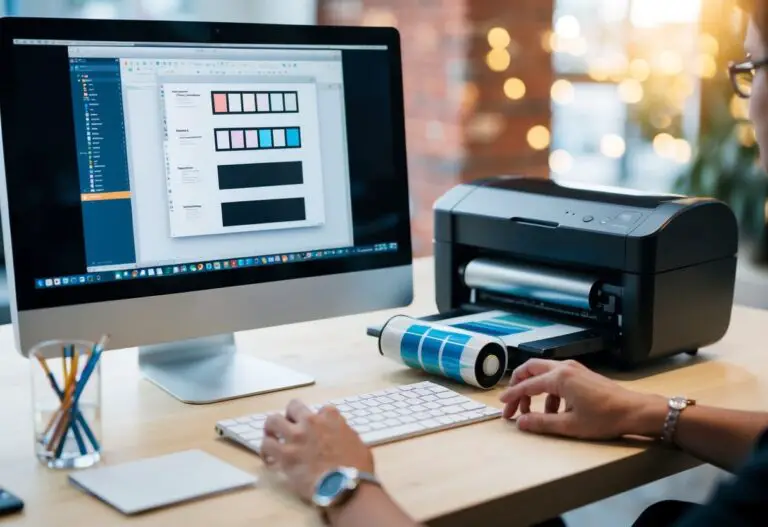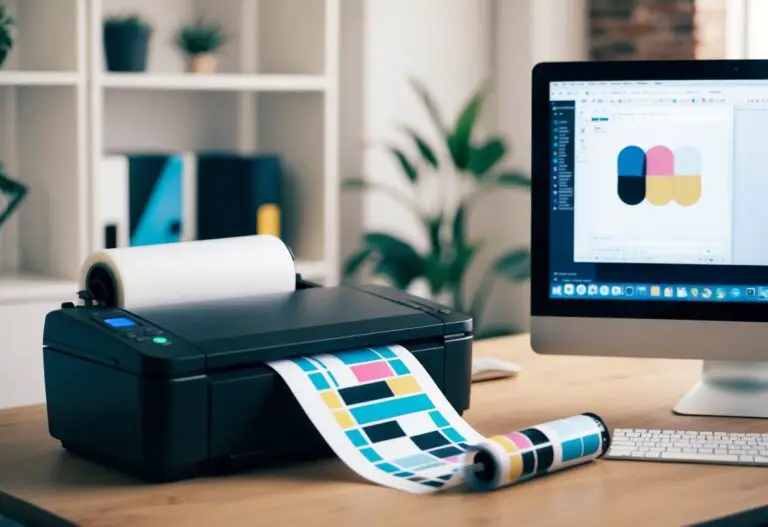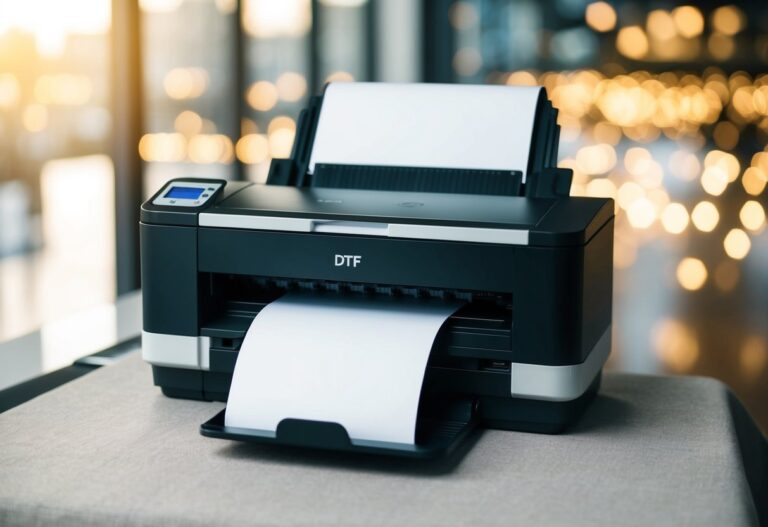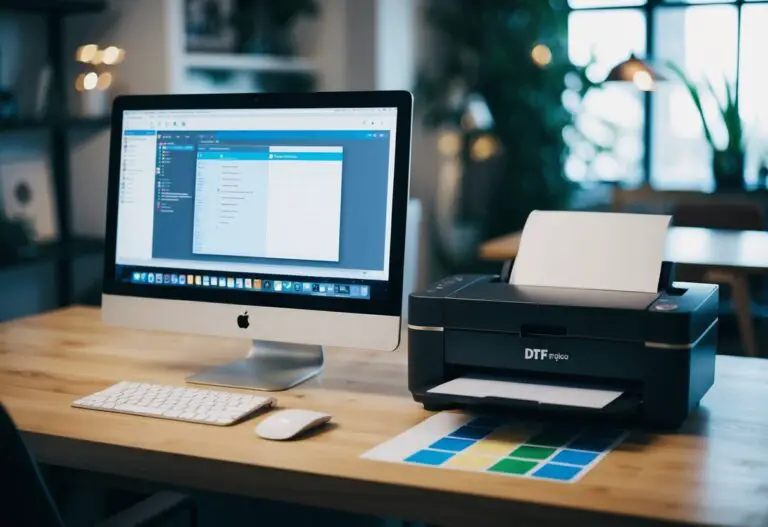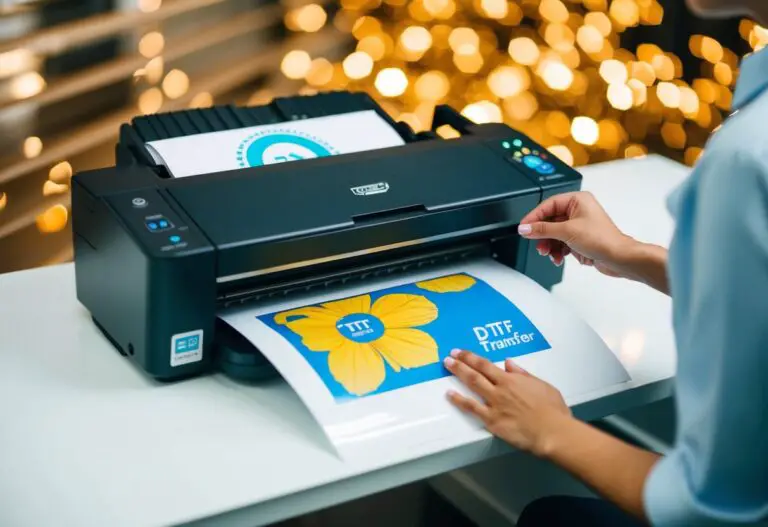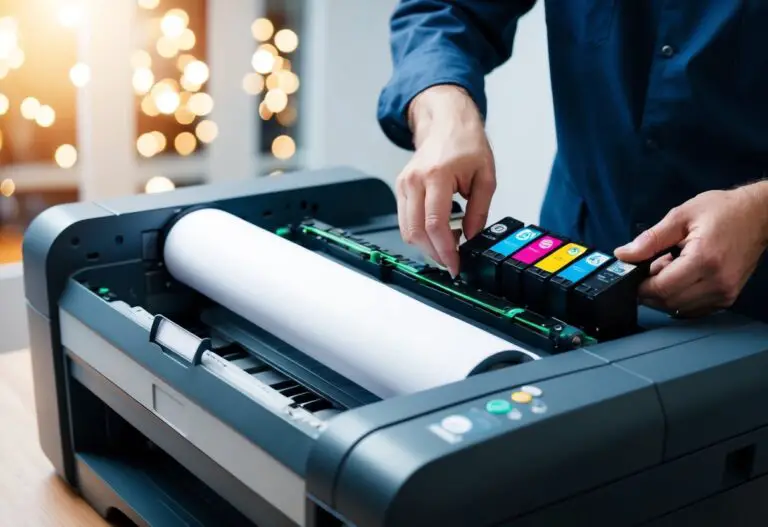Looking for a good DTF printer? You’ve come to the right place. DTF printing is changing the game for custom apparel and promotional items. It allows you to print on various fabrics, plastics, and more with vibrant colors and durable results.

The best DTF printers for small businesses include the Epson L1800, Epson XP 15000, and Epson SureColor P800. These models offer high-quality prints and meet the specific needs of DTF printing. They’re known for their versatility and ability to produce sharp graphics on different materials.
When choosing a DTF printer, think about print quality, speed, and ease of use. Some printers, like the Tenee DTF Printer, have special features to prevent printhead blockages and ensure smooth transfers. Others, like the Prestige A4, are good for beginners but may need frequent use to stay in top shape.
Key Takeaways
- DTF printers allow for versatile printing on various materials with vibrant colors
- Top DTF printer brands include Epson, Tenee, and Prestige
- Consider print quality, speed, and maintenance needs when selecting a DTF printer
Key Features Of A Good DTF Printer
When choosing a DTF printer, look for high print quality and resolution. A good printer should produce sharp, detailed images with at least 1200 dpi resolution. This ensures your designs look crisp and professional.
Print speed matters too. A quality DTF printer can handle 100-150 shirts per hour, letting you fulfill orders quickly. Fast turnaround times keep customers happy and boost your productivity.
Color accuracy is crucial for eye-catching designs. Pick a printer that delivers vibrant, true-to-life colors. This helps your prints stand out and match client expectations.
Durability is key for long-lasting transfers. Your chosen printer should create designs that withstand washing and wear. This builds trust in your products and keeps customers coming back.
Easy operation saves you time and hassle. Look for user-friendly interfaces and simple maintenance procedures. This cuts down on training and upkeep costs.
Versatility adds value to your printer. Choose a model that works well with different fabric types. This lets you expand your product range and take on more varied projects.
Top DTF Printer Brands And Models
Several brands offer excellent DTF printers for small businesses. Epson is a top choice, with models like the EcoTank and SureColor series. These printers deliver high-quality prints and are known for their reliability.
Brother’s GTX Pro is another strong contender. It’s user-friendly and produces vibrant, durable transfers. The Ricoh Ri 1000 is also worth considering for its versatility and speed.
For budget-conscious buyers, the DSV A3 L1800 Transfer Printing Machine is a good option. It offers decent print quality at an affordable price point.
The Prestige A3+ DTF Printer is popular among small businesses for its balance of performance and cost. It handles a variety of fabric types well.
When choosing a DTF printer, consider:
• Print quality
• Speed
• Ease of use
• Maintenance requirements
• Cost of ink and materials
Compare features across brands to find the best fit for your needs. Remember, the right printer can help you create professional-looking custom apparel efficiently.
Print Quality And Resolution
Print quality is key for DTF printing. The resolution, measured in dots per inch (dpi), plays a big role. Higher dpi means sharper, more detailed prints.
For DTF, a resolution between 600 and 1200 dpi works well. This range gives clear, vivid prints without slowing down the process too much.
Several factors affect print quality:
- Ink type
- Film quality
- Printer settings
To get the best results, use high-quality DTF ink and compatible film. Make sure your printer is set up right for the job.
Many DTF printers can print at 1440 dpi or higher. This is great for very detailed designs. But remember, higher resolution means slower printing.
You can adjust the resolution based on your needs. For simpler designs, lower dpi might work fine. For complex images with lots of detail, go higher.
Keep an eye on your ink levels. Low ink can lead to poor quality prints. Regular printer maintenance also helps ensure consistent, high-quality output.
Printing Speed And Efficiency
DTF printer speed can make a big difference for your business. Most models print between 30-60 shirts per hour. Faster printers may do up to 100 shirts hourly.
Print speed depends on a few things. Complex designs with lots of colors take longer. Simple designs in 1-2 colors are quicker. The size of your print also matters – larger prints need more time.
DTF printing is often faster than screen printing for small batches. It beats heat transfer vinyl too. But for huge orders, screen printing may win on speed.
Many DTF printers offer wireless printing. This lets you send designs from your computer without cables. It can speed up your workflow.
Some printers have automatic heat stations. These press the transfer onto the shirt for you. This saves time compared to using a separate heat press.
Printing width affects speed too. Wider printers let you print more designs at once. This boosts your overall output.
Check the ink consumption of different models. Efficient ink use means fewer refills and less downtime.
Fast print speeds are great, but don’t forget about quality. Look for printers that balance speed and print sharpness.
Color Accuracy And Vibrancy
DTF printers can produce vibrant colors and accurate prints. The color gamut of these printers is wide, letting you create eye-catching designs. CMYK ink systems are common in DTF printing. They use cyan, magenta, yellow, and black inks to make a range of colors.
Some DTF printers use more than four colors. This can give you even more vivid prints. For example, some use six-color systems with light cyan and light magenta. These extra colors help make smoother gradients and more lifelike images.
White ink is key in DTF printing. It helps colors pop on dark fabrics. You can adjust the amount of white ink to change how bright your prints look.
Color management is vital for accuracy. You’ll want to calibrate your printer often. This makes sure the colors you see on screen match what prints on the fabric. Many DTF printers come with built-in color management tools to help you get the best results.
To get the most vibrant prints:
- Use high-quality inks
- Choose the right settings for your design
- Pick fabrics that work well with DTF printing
Remember to do test prints. They help you fine-tune your color settings before big jobs. With practice, you’ll be able to create stunning, color-accurate designs on various materials.
Durability And Wash Resistance
DTF prints are tough and long-lasting. You can expect them to withstand many washes without fading or peeling. Most DTF prints can survive 50 or more washes while staying vibrant.
The durability of DTF prints depends on a few key factors:
• Heat press settings
• Hot melt powder quality
• Proper curing process
To test wash resistance, many printers use standardized methods like the AATCC Test Method 61. This test simulates multiple home launderings to check how well the print holds up.
For best results, make sure to:
- Use high-quality hot melt powder
- Follow the recommended curing time and temperature
- Pre-treat fabrics if needed
With proper application, your DTF prints can last for years. They’ll stay bright and clear through regular wear and washing. This makes DTF a great choice for clothing and other washable items.
Remember, the right equipment and techniques are crucial. A good DTF printer paired with the correct heat press settings will give you durable, wash-resistant prints every time.
Ease Of Use And Maintenance
When choosing a DTF printer, ease of use and maintenance are key factors to consider. User-friendly interfaces make operating the printer simpler, even for beginners. Look for models with touchscreen controls and intuitive menus.
Many printers now offer automated features that reduce manual work. These can include:
- Built-in white ink circulation systems
- Automatic printhead cleaning
- Air suction systems for smooth paper feeding
Regular maintenance is crucial for DTF printers. Check how often the printer needs cleaning and what supplies are required. Some models have refillable ink tanks, which can save money and reduce waste compared to cartridge systems.
Consider the printer’s design as well. A compact printer may be easier to fit in your workspace. Some printers include roll feeders, allowing you to print larger designs without constant paper changes.
The software that comes with your printer matters too. Good RIP software can make preparing and sending print jobs much easier. Check if the manufacturer offers training or support to help you get started.
By choosing a printer that’s easy to use and maintain, you’ll spend less time troubleshooting and more time printing. This can lead to smoother operations and better results for your DTF printing projects.
Frequently Asked Questions
DTF printers come in different models suited for various needs. The right choice depends on your budget, business size, and printing goals. Let’s look at some key questions about selecting a DTF printer.
What are the recommended DTF printers for beginners just starting in the industry?
For beginners, user-friendly DTF printers are best. The Prestige A3+ DTF Printer is a good option for home use. It’s compact and prints up to 13×19 inches.
You can start with desktop models that have a small footprint. These printers are easier to set up and use. Look for ones that come with clear instructions and training videos.
Which DTF printer models are considered the best for small businesses in 2024?
Small businesses need reliable, efficient DTF printers. Top models in 2024 offer high print quality and speed.
Look for printers with good customer support. This helps when you need troubleshooting or maintenance. Check online reviews to see which brands other small business owners recommend.
Some printers come with software for design and color management. This can be very helpful for creating professional-looking prints.
What are the cost vs. benefit considerations for investing in a DTF printer?
DTF printers can be a big investment. Think about your printing needs and budget. A cheaper printer might cost more in the long run if it breaks down often.
Higher-end models may offer better print quality and faster speeds. This can help you take on more orders and grow your business. But they also cost more upfront.
Consider the cost of supplies like ink and transfer films. Some printers use less ink, which can save money over time. Look at the total cost of ownership, not just the initial price tag.
Training resources are important too. Some companies offer free online courses or in-person workshops. This can help you get the most out of your printer and avoid costly mistakes.
